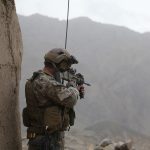Hacking For Defense Pedagogy: Experiential Learning
Hacking for Defense is a hands-on program that immerses student teams by having them test their business model hypotheses outside the classroom. Inside the classroom, it deliberately trades off lecture time for student/teaching team interaction.
Hacking for Defense uses the Customer/Beneficiary Development process and the Mission Model Canvas to collapse the infinite possibilities of a startup into a set of solvable problems. This class uses experiential learning as the paradigm for engaging the participants in discovery and hypotheses testing of their business models. From the first day of class, teams get out of the classroom and learn by doing. Experiential learning has been around forever. Think of guilds and the apprentice system: mentors were the master craftsmen. That’s the core idea behind the structure of this class.
 This is very different from how a typical business school “how to write a business plan” class works. There, it assumed a priori that there was a valid business model. In the Hacking for Defense class, the teams are not building a business (yet). Information they learn from beneficiaries will inform them and validate/invalidate their hypotheses (thesis). Throughout the course the teams will modify the mission model (as they iterate or pivot). This results in the teams bringing sponsor needs and market needs in dual use cases forward, after which they can decide if there’s a worthwhile business to be built.
This is very different from how a typical business school “how to write a business plan” class works. There, it assumed a priori that there was a valid business model. In the Hacking for Defense class, the teams are not building a business (yet). Information they learn from beneficiaries will inform them and validate/invalidate their hypotheses (thesis). Throughout the course the teams will modify the mission model (as they iterate or pivot). This results in the teams bringing sponsor needs and market needs in dual use cases forward, after which they can decide if there’s a worthwhile business to be built.
What this class does not include is execution of the business model. This course is all about discovery outside of the classroom. As this discovery process unfolds it results in a high degree of confidence that a viable business model exists, then and only then would be the time to create an execution plan. If the student teams continue with their companies, they will assemble the appropriate operating plans (e.g., financial models, revenue plans, cash flow statements, balance sheets, etc).
The Flipped Classroom
The class is run using a “flipped classroom.” Instead of lecturing about the basics during class time, the instructor assigns the core lectures as homework. Steve Blank has recorded eight 30-minute class lectures, each with quizzes to support the Lean LaunchPad course. Similar class lectures will be made available for students in the Hacking for Defense course. Students watch a lecture on each component of the Mission Model Canvas take a short quiz, and come to a class prepared with questions about the topic. Students will use that new knowledge to test that specific part of the mission model.
(Of course, if they prefer, instructors could deliver the lectures in person.) Instructors then supplement the video lectures with their own in-class short lecture about the week’s mission model topic. This allows instructors to use the class time for review of the concepts or advanced topics.
Check out an example of an H4D student team produced video of their work during the class!
